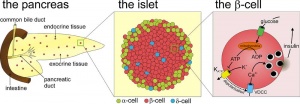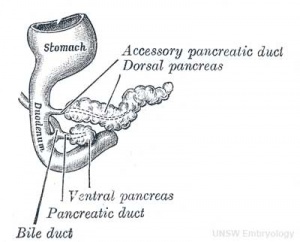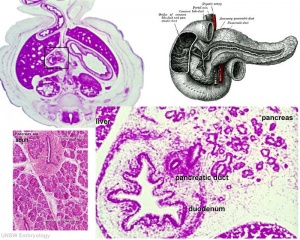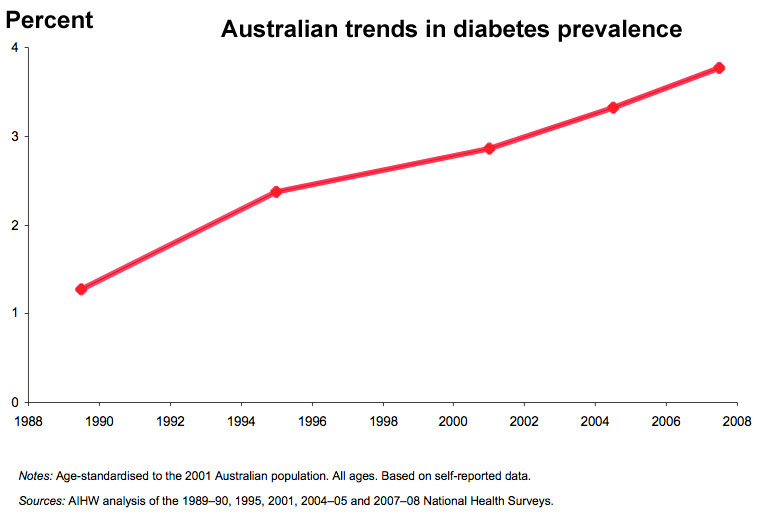Endocrine - Pancreas Development
div style="background:#F5FFFA; border: 1px solid #CEF2E0; padding: 1em; margin: auto; width: 95%; float:left;">
Currently this page is only a template and will be updated (this notice removed when completed).
Introduction
The pancreas is a two-headed organ, not only in origin but also in function. In origin, the pancreas develops from two separate primordia. In function, the organ has both exocrine (digestive) and endocrine functions in relation to regulating blood glucose and also other hormone secretions.
In recent years there has been much research due to the increasing incidence of diabetes in humans and the potential for stem cell therapeutics. Much is now known about the epithelial/mesenchymal and molecular regulation of pancres development.
At the foregut/midgut junction the septum transversum generates 2 pancreatic buds (dorsal and ventral endoderm) which will fuse to form the pancreas. The dorsal bud arises first and generates most of the pancreas. The ventral bud arises beside the bile duct and forms only part of the head and uncinate process of the pancreas.
In the fetal period islet cell clusters (icc) differentiate from pancratic bud endoderm. These cell clusters form acini and ducts (exocrine). On the edge of these cell clusters pancreatic islets (endocrine) also form. Pancreatic hormonal function is to secrete insulin and glucagon which together regulate blood glucose levels and also somaostatin.
The pancreas exocrine function begins after birth, while the endocrine function (hormone release) can be measured from 10 to 15 weeks onward. At this stage, it is not clear what the exact roles of these hormones are in regulating fetal growth.
| Lecture- Gastrointestinal Tract Development | original page
- Functions - exocrine (amylase, alpha-fetoprotein), 99% by volume; endocrine (pancreatic islets) 1% by volume
- Exocrine function - begins after birth
- Endocrine function - from 10 to 15 weeks onward hormone release
- exact roles of hormones in regulating fetal growth?
Some Recent Findings
|
Pancreas Development
- Pancreatic buds - duodenal level endoderm, splanchnic mesoderm forms dorsal and ventral mesentery, dorsal bud (larger, first), ventral bud (smaller, later)
- Pancreas Endoderm - pancreas may be opposite of liver
- Heart cells promote/notochord prevents liver formation
- Notochord may promote pancreas formation
- Heart may block pancreas formation
- Duodenum growth/rotation - brings ventral and dorsal buds together, fusion of buds
- Pancreatic duct - ventral bud duct and distal part of dorsal bud, exocrine function
- Islet cells - cords of endodermal cells form ducts, from which cells bud off to form islets
Pancreatic Islets
- Islets of Langerhans - 4 endocrine cell types
- Alpha - glucagon, mobilizes lipid
- Beta - insulin, increase glucose uptake
- Beta cells, stimulate fetal growth, continue to proliferate to postnatal, in infancy most abundant
- Delta - somatostatin, inhibits glucagon, insulin secretion
- F-cells - pancreatic polypeptide
Pancreas Timeline
- Week 7 to 20 - pancreatic hormones secretion increases, small amount maternal insulin
- Week 10 - glucagon (alpha) differentiate first, somatostatin (delta), insulin (beta) cells differentiate, insulin secretion begins
- Week 15 - glucagon detectable in fetal plasma
Diabetes
References
- ↑ <pubmed>20377917</pubmed>
Reviews
Articles
Search PubMed
Search April 2010
- Endocrine Development - All (14277) Review (4620) Free Full Text (3140)
Search Pubmed: pancreas development
Additional Images
Adult Histology
Terms
Glossary Links
- Glossary: A | B | C | D | E | F | G | H | I | J | K | L | M | N | O | P | Q | R | S | T | U | V | W | X | Y | Z | Numbers | Symbols | Term Link
Cite this page: Hill, M.A. (2024, June 26) Embryology Endocrine - Pancreas Development. Retrieved from https://embryology.med.unsw.edu.au/embryology/index.php/Endocrine_-_Pancreas_Development
- © Dr Mark Hill 2024, UNSW Embryology ISBN: 978 0 7334 2609 4 - UNSW CRICOS Provider Code No. 00098G







